Proceeding of a clearing
The proposed markings, warning notices, safety areas and safety margins
are identically to the SOP of manual demining actions and are obligatorily
taken, used, and kept. The details are not described more exactly
here for they are considered as known to the experts.
KMMCS operates in two procedures:
1. Mechanical mine clearing operation by activating or destroying
functional and not functional mines and other combustible agents of
all kinds (bazookas, hand grenades, small rockets etc.) with the mill
of the machines I or II. Even at the way to the mine-suspected area
the machine has to mill its path with minimum of 20 cm depth.
2. Internal Quality Control with aftercare of the cleared area (visual
survey without neccessity for the person to have physical contact
to the soil and secure removal of not fully broken mine debris) with
machine III and the attachments disk harrow and Cambridge Roller.
The contractor exactly defines mine-suspicioned areas and minefields
by specification of the coordinates or by landmarks.
At mine-suspicioned areas Machine I or Machine II mills once.
Mine
fields on which several mines were found especially close to each
other are milled twice for safety reasons.
Both mine suspicion areas and mine fields are treated with following
Internal quality control. Mine suspicion areas are controlled once
with the machine III, mine fields several times.
The employed Machines I, II und III
Machine I and Machine II destroy explosives
Machine I and Machine II are equal. They are mostly used in minefields
together as a clearing unit, so in case of a defect the other machine
can rescue the broken one from the minefield in a safe manner.
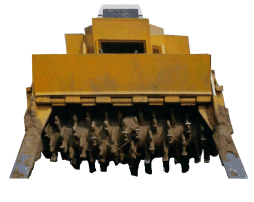
This machine is equiped with a 3 m wide double-mill, rotating contrary
to the direction of the driving. It can work with an operating speed
of 1-3 km/h and, depending on need, with exactly pre-defined soil-depth
up to 50 cm.
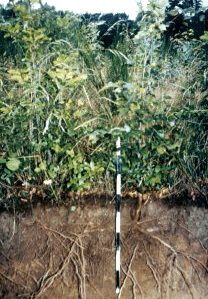
All detonable mines explode during the de-mining process.
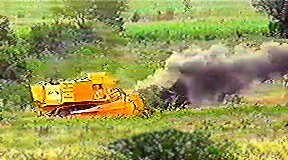
All undetonated personal mines and anti-tank mines and also other
objects like tree, trunks, bush, concrete parts and other similar
obstacles are all disintegrated.
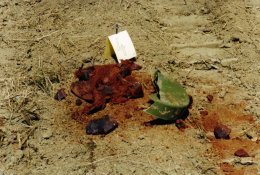
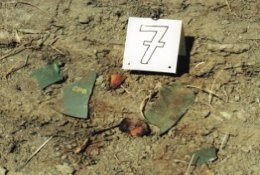
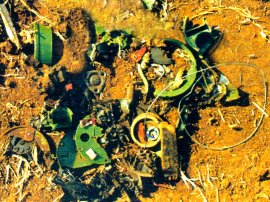
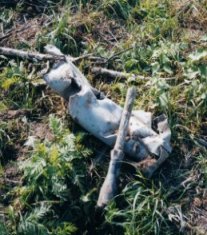
The vegetation is evenly replaced back in the soil.
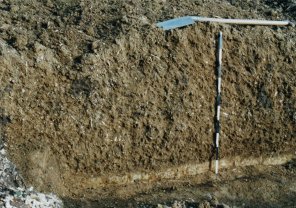
The
black and white painted stick shows the depth of 100cm to that the
white wooden shred have been evenly mixed from the surface by the
Krohn Machines into the full volume of the soil in this demonstration.
The white line shows the solid ground.
The UN requirements for depth is 20 cm for manual demining, but our
machines achieve with normal setup up to 50 cm working depth into
the soil. That exeeds up to 2,5× the normal working depth if needed.
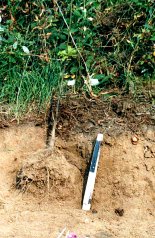
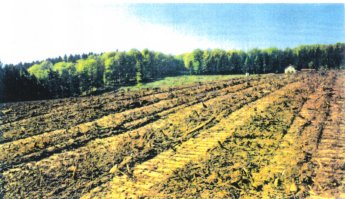
The machines, which have 3 m wide twin roters, ploughs 50 cm overlapping
stripes through the complete volume of the minefield that is totally
overturned that way.
The driving at a minefield or a mine suspected area is allowed only
in conjunction of milling with minimum depth of 20cm.
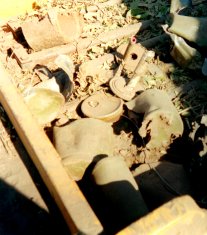
At practical work was proven that only a small number of the mines
actually explode because the system destroys most mines from their
bottom before they have the chance to explode by the ignator, that
is at the top side.
Our machines protect the operating driver from explosion splinters
which are equivalent to 10kg TNT. The strongest Anti Tank-Mines (ATM)
known have a detonation power of 5-7kg TNT equiv., very rarely 10kg
TNT equiv.
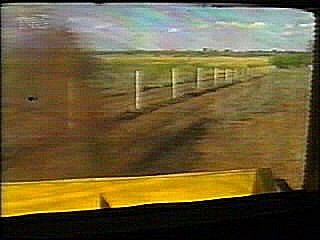
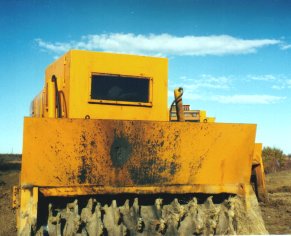

In front of the machine a hollow charge of 6 kg TNTequiv. exploded
without damaging the machine.
Accidently existing mines with extreme thick case (approx. 1 cm cast-iron)
are all cut from their outer ignator, but may not be disrupted totally
on a mechanical manner.
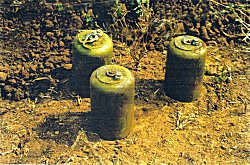
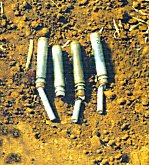
These
UXO´s (UXOs - unexplosive objects, here MUXO´s) with thick steel case
and already separtated ignator are collected and destroyed in the
following working process, the Internal Quality Control with Aftercare,
to prevent the reuse.
Machine III for Quality Control
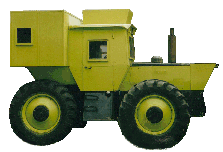
This machine serves as vehicle for the internal quality control and
helps the machines I and II in case of breakdown. The machine III
is only allowed to roll at the soil that already had been milled.
The machine III can have a different apperance to this picture.
Internal Quality Control with aftercare
After the mechanical demining with machine l or II ALL mines and UXO´s
are destroyed. The level of safety is even over 99,9%.
For security reasons an internal quality control with aftercare is
done.
Mechanical agriculture machines are used. They have to be adapted
to the local soil conditions for each project. As standard machine
is declared:
At machine III a combination of a disk-harrow (to turn the soil and
uncover hidden mine-fragments) and a Cambridge Roller (breaking up
earth-clod and flattening the area) is attached.
At the back of this combination over the full width of 3 m a platform
with 3 seats is located, from where 3 controllers can watch a strip
of 5 meters without touching the ground. Suspected pieces are marked
with colorspray. The Operation's Supervisor identifies the fragments
and decides how to waist them regarding the local regulations.
As far as necessary the fragment is milled by the machine l or II
and mechanically destroyed.
A minefield is treated several times with the combination attachment
and controlled.
Doing so the area is prepared for seed or planting.
Should the control detect a clearance fault, that is a mine with intact
ignator or other dangerous piece, that may explode by touch or pressure
(misshandling), that piece has to be marked and one machine mills
this area again.
In case there is an explosion the fragment is regarded as a clearance
fault and the area of 1 ha around this point has to be milled again.
In case there is no explosion then the marked piece is not regarded
as a clearance fault.
The control then certifies the area as free from dangerous explosives.
After this "Internal Quality Control with aftercare" the area is reported
as minefree and ready for final external certification to the customer.
The final external certification by the customer also can be done
at the last drive. By that the full 100% of the area can be controlled
by the authorities of the customer and not only some spots of 5-10%
of the area as usually done by manual demining.
The working speed of machine III is up to 6 km/h, the working width
is 3 m.
The field is free from mines and dangerous explosives now and can
be be certified by authorities from theMine Action Center.
















